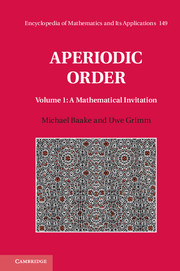Book contents
- Frontmatter
- Contents
- Foreword
- Preface
- Chapter 1 Introduction
- Chapter 2 Preliminaries
- Chapter 3 Lattices and Crystals
- Chapter 4 Symbolic Substitutions and Inflations
- Chapter 5 Patterns and Tilings
- Chapter 6 Inflation Tilings
- Chapter 7 Projection Method and Model Sets
- Chapter 8 Fourier Analysis and Measures
- Chapter 9 Diffraction
- Chapter 10 Beyond Model Sets
- Chapter 11 Random Structures
- Appendix A The Icosahedral Group
- Appendix B The Dynamical Spectrum
- References
- List of Examples
- List of Remarks
- Index
Chapter 8 - Fourier Analysis and Measures
Published online by Cambridge University Press: 18 December 2014
- Frontmatter
- Contents
- Foreword
- Preface
- Chapter 1 Introduction
- Chapter 2 Preliminaries
- Chapter 3 Lattices and Crystals
- Chapter 4 Symbolic Substitutions and Inflations
- Chapter 5 Patterns and Tilings
- Chapter 6 Inflation Tilings
- Chapter 7 Projection Method and Model Sets
- Chapter 8 Fourier Analysis and Measures
- Chapter 9 Diffraction
- Chapter 10 Beyond Model Sets
- Chapter 11 Random Structures
- Appendix A The Icosahedral Group
- Appendix B The Dynamical Spectrum
- References
- List of Examples
- List of Remarks
- Index
Summary
In this chapter, we recall some basic facts from Fourier analysis which we need for our approach to diffraction theory in Chapter 9. Since Fourier series and their generalisations to almost periodic functions occur only occasionally below, we keep their exposition brief and informal (mostly without proofs, but with proper references). Subsequently, Fourier transforms of functions and measures are covered in more detail, including a brief introduction to volume-averaged (or Eberlein) convolutions.
Fourier series
A (possibly complex-valued) function f of one real variable is called periodic, if f (x + T) = f(x) holds for some T ≠ 0 and all x ∈ ℝ. Clearly, one then has f(x + nT) = f(x) for all n ∈ ℤ. Assuming that the periodic function f is not a constant function, the smallest T > 0 with this property is the fundamental period of f. It is simply called the period of f when misunderstandings are unlikely. Examples are provided by trigonometric functions, such as sin(x), cos(x) or eix, all three with fundamental period T = 2π. A natural way to look at such functions in a more general setting is to consider T-periodic functions that are locally integrable (over any compact set K ⊂ ℝ say), so that one can also view them as elements of the Banach space L1([0, T]); see [DMcK72, Kat04, Pin02] for general background.
- Type
- Chapter
- Information
- Aperiodic Order , pp. 303 - 332Publisher: Cambridge University PressPrint publication year: 2013



